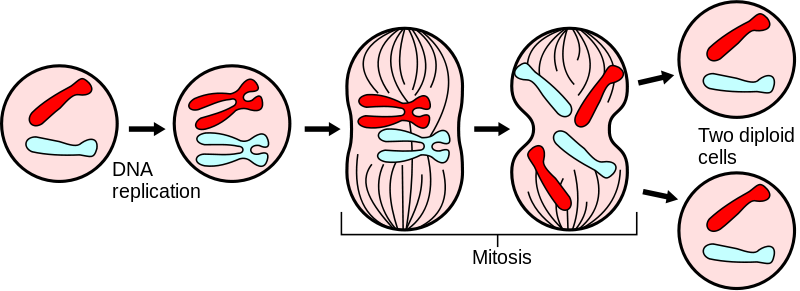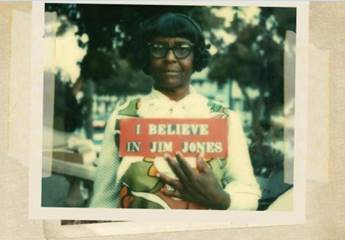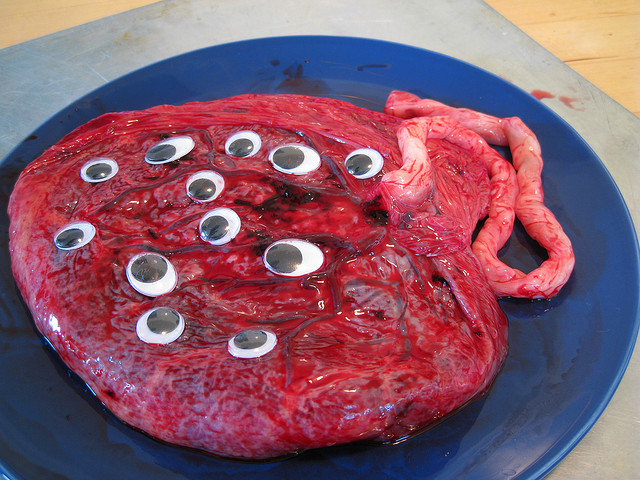Guest Post: The Science Behind Three-Parent Babies (and Why the Name is a Little Misleading)

Ed’s note: The author of this post is Andrew, a Cell Biologist (more information at the bottom).
———————————
Every so often, a discovery is made, a technology is developed, or a news item comes out that seems to be tailor-made for misleading descriptions. From evolution’s “missing link” to the metamaterials “Harry Potter invisibility cloak,” some things just beg to be oversimplified and hyped-up. The FDA is considering a new technique that has been all over the news, and fits nicely into this category: Three-Parent Babies. If you don’t quite get the science behind this technique, I’m going to try to give an overview of what is happening address some of the misconceptions.
Intro Bio Background:
A typical human has 46 chromosomes, organized into pairs. When a sperm or egg cell is made, it gets one copy from each of those pairs, resulting in 23 chromosomes. It’s not a truly random assortment—the chromosomes don’t get mixed up and 23 random ones chosen, for example. Each sperm and egg cell get one chromosome from each pair (this will be important later).
With normal fertilization, a sperm cell from the father meets an egg cell from the mother, and you get an embryo (bow-chicka-wow-wow). The sperm cell is just a delivery system for the father’s chromosomes, with a flagellum, some enzymes, and a bunch of mitochondria—virtually all of which fall away after it delivers its genetic material. The egg cell is where all of the “other stuff” is—it’s a giant cell, full of proteins, enzymes, membranes, and organelles (including mitochondria).
New Technology:
This technology simply introduces a third person to provide part of the egg. A third person donates an egg, and its nucleus is removed. An egg is taken from the mother and its nucleus is transferred into the donor’s egg. It gets fertilized by sperm from the father, becomes an embryo, and from that point on, it’s normal IVF. In effect, the egg that gets used comes from two people – its nucleus is from the mother, and the cell with all of the other “stuff” comes from the third donor.
The “stuff” is the important part. Among other things, it contains mitochondria. They’re the power plant of the cell, but they’re unusual because they have their own DNA. It’s left over from when they used to be free-floating bacteria, before they evolved into a symbiotic relationship with our single-celled ancestors. Since they have their own DNA, they can have their own mutations, which can, in turn, lead to a whole bunch of problems. The result of this technology is to allow a couple to reproduce mostly with their own genes but “replace” the faulty mitochondria.
Since mitochondria have their own DNA, they can suffer from mutations that can to serious detrimental effects, such as blindness, deafness, neurological problems, and metabolic diseases. Like many genetic diseases, these problems can be debilitating, life-threatening, and extremely difficult to treat. While this technology can’t be used to treat mitochondrial disorders, it can be used to allow affected individuals to have children without the risk of passing the disorder on to them.
The Misconception:
The big misconception is right in the name of the technology: Three-parent babies. That gives the impression that embryos are being produced with a 1:1:1 contribution from all three parents. It’s kind of inaccurate to say that these are three-parent babies though, since all that comes from the third parent is the mitochondria. Humans have something like 20,000 genes—and since chromosomes are in pairs, those genes are in duplicate. Mitochondria have 37 genes. That comes out to 0.09% from the “third parent.”

I don’t think we’re anywhere near being able to make true blends of multiple parents. When a cell divides, its chromosomes sort themselves out by finding their pair (by certain regions of DNA sticking to each other) and lining up along the center of the cell. Microtubules form, attach to each one of the chromosomes, and pull to opposite sides of the cell. This splits up the chromosomes, making sure that each cell gets one from each pair. This works great on the microscopic scale inside the cell, but it’s not really something that we can do by hand. Chromosomes are only visible at a certain stage of cell division, and it doesn’t last very long (we can chemically “pause” it, but this comes with its own problems). Chromosomes are also too tiny for us to manually move around, and even if we could, we don’t have any way of identifying chromosomes without chemically modifying them—there’s no way of knowing whether you’re looking at Chromosome 1, Chromosome 2, Chromosome 3, etc., without taking them all out and chemically modifying them.
This is important, because a healthy human doesn’t just need 46 chromosomes—they need 23 pairs of specific chromosomes. In order to make true three-parent babies, you would need to be able to positively identify each chromosome, and then have a method to isolate it and move it around. The technology we’re looking at now doesn’t need that level of finesse. It simply takes the nucleus from one cell (which already contains the necessary chromosomes, and is big enough to move around with a fine needle) and pops it into another cell.
As a final note, I don’t think that this technology falls under the category of “designer babies.” We’re not talking about mixing and matching different traits, or modifying genes. It simply replaces all of the mitochondria from the mother with mitochondria from the third donor. All 37 of those genes come over as a bundle. If anything, I’d call this more of a transplant than real design or engineering. Calling it genetic engineering or “designer babies” would be like calling me a fashion designer by virtue of the fact that I can pick a pair of pants and a shirt out of my dresser that (usually) don’t look terrible together.
So, in case you’re in a TL;DR type of situation, but you’re somehow still reading my last paragraph, here’s the recap:
- This technique doesn’t result in true 3-parent babies, since the baby gets 22,000 genes from the father, 22,000 from the mother, and 33 from the 3rd donor. It’s more like 2.0009-parent babies
- This technique can’t be modified to make multi-parent babies, since we’re nowhere near being able to manipulate individual chromosomes to the necessary extent.
- The resultant neonates are not “designer babies” since the only change from normal IVF is that faulty mitochondria from the mother get swapped out with healthy mitochondria from an egg from a female donor. The mitochondrial genes are only 0.09% of the child’s final genome, and the parents can’t pick and choose what genes come over—it’s all or none of the mitochondria from the third donor.
————————————-
Author Bio: Andrew is a cell biologist who spends his days in a molecular biology lab teaching students and nights painting miniatures and tending his ongoing biology experiment, a.k.a. his daughter. (He is also Mary’s husband, affectionately referred to as Spousal Unit 3000.)





When I first read the article about 3-parent babies it led me to so many misconceptions. You really explained what was actually going on really well. Thanks for taking the time to write this, Andrew!
Thanks! Glad to help :)
Scifi is usually the worst culprit (at least it has an excuse in that it’s not real), but I’ve had a lot of facepalm moments with science news too. It’s not really the misconceptions that bother me so much, but the fact that different news outlets keep repeating the same misconceptions over and over. I suppose it doesn’t help that one of the bigger problems is in e name itself.
In general, the MSM have trouble understanding the science. We’re talking about preventing life-threatening disorders, though because the law wrt: voluntary eugenics (e.g., human cloning, genetically engineering humans) is poorly worded, and because the phrase ‘three-parent baby’ is used, it sounds far more sinister than it is.
It doesn’t help much that, well, our image of this type of thing is influenced by SF. SF is often wrong; I have a video phone, for instance, but it’s portable. I have a bunch of lasers, since the laser apparently found numerous problems, but none of them are lethal weapons. In The Meaning of Liff, Douglas Adams and Jonathan Lloyd actually called it Zeerust, after the South African city of the future. (Disclaimer: As imagined in the 1960s, and only if you’re white, because South Africa, 1960s.)
But even worse than SF, really, an actual scientist is given equal weight in the MSM with someone who says quantum entanglement proves sympathetic magic is real.
This post not only clears up misconceptions about this particular development but fills in some gaps in my knowledge about basic genetics that I didn’t know were there. So clearly written, I can actually remember this accurately enough to explain to other people. Thanks so much!
Also: I’m looking forward to Babies of 2.0009 Parents Group forming on on Baby Center.
When I heard the objections to this technology and then the scientific explanation of what was happening, I was pretty confused, because it seemed like they were talking about completely different things. Now it has been confirmed, they are. This seems like a pretty reasonable technological solution to a specific set of genetic problems caused by faulty mitochondria.
Question I have is: Does this mean mitochondrial defects are always passed on from mother to child, never from father to child, and is it 100% of the time, or less than that?
Thanks.
The mitochondria always come from the mother. The egg is basically a giant cell, with enough stuff inside to keep it alive and support a few cell divisions until the embryo implants in the uterine wall. The only thing that sperm contributes is DNA. Sperm do have mitochondria, and there have been cases under lab conditions where the sperm’s mitochondria have made it into a fertilized cell, but they get broken down pretty quickly. I think there’s one recorded case of stable mitochondrial inheritance from a father – so it’s possible, but definitely not the norm. Even in that incredibly rare case, though, you’d still have the malfunctioning mitochondria from the mother, and probably not enough healthy mitochondria from the father to compensate.
I’m not sure if mitochondrial diseases are passed on 100% of the time, but I’d guess that the answer is probably no. All of the genes in the mitochondira are related to metabolism, but they still only comprise a tiny fraction of metabolism in general. It probably depends on exactly what kind of disease and the mutations involved – there can be some complex interplay between mitochondrial and nuclear genes. There are probably some mitochondrial diseases that depend on certain mutations being present in the nuclear DNA, and some that result in disease most, if not all, of the time.
Inheriting mitochondria from the father is known as ‘paternal leakage’. There are active defences in the ovum to prevent this. (It isn’t simply a matter of the quantity of mitochondria in the sperm being minute compared to that in the ovum, although this is also true.) Paternal leakage is usually very rare – one study examined about 10,000 salmon without finding a single instance. It is, however, considerably more common in hybrids.
Because each cell has many mitochondria, it is possible for an individual to have a mixture of diseased (i.e. deleteriously mutated) mitochondria and healthy mitochondria. (Heteroplasmy is the term for having non-identical genomes.) Random processes of how many of which type of mitochondria end up in each cell during division can mean that the healthy/diseased mitochondria ratio can be different in different parts of your body. You could potentially have such a mixture and produce an ovum with no diseased mitochondria, if you got lucky and your germ-line cells got few or no diseased mitochondria. (Or the converse could happen, where you have few enough diseased mitochondria to be asymptomatic, but all your children will get a large dose.)
A plausible hypothesis is that the exclusion of paternal mitochondria is probably to avoid perpetuating mitochondria which are better than average at reproducing themselves at the expense of being good at being mitochondria.
Awesome post, Andrew. Thanks for helping us better understand this.
Andy, this is beautifully written and crystal clear. I heard about the “3-parent baby” on this week’s SGU podcast, and thought this might be what was going on, but this post explains it so well.
Like all good science (Curse you, Science and your inevitable betrayal!) it leads to more questions, though. Filias Cupio answered one of them: what happens to the paternal mitochondria and why? Other things I wonder about are are there other organelles (or other structures) with their own DNA or just mitochondria? (I think I’ve read that chloroplasts also have their own DNA.) Do all eukaryotic cells have mitochondria? Does the fact that there are lots of mitochondria in each cell (usually with identical DNA?) mean that mutations of their DNA don’t propagate swiftly and deleterious mutations aren’t invariably harmful? So how, if this is the case, do mitochondrial mutations propagate? (I know that they must be common enough that they can be used to identify maternal lines among people, at least if Law & Order and CSI are to be believed.) Do mutant mitochondria in your biology experiment give her the power to kill you with her brain? And a zillion more :-)
Two tiny nits and a big complaint: There’s a dropped word (probably “lead”) in the 1st sentence of the 6th paragraph, and you twice say mitochondria have 37 chromosomes, but the summary at the end implies they have 33. Typos? And the big complaint: the title of this post says it is a guest post, but you have to get all the way to the end before Mary gives you proper credit!
“I wonder about are are there other organelles (or other structures) with their own DNA or just mitochondria? (I think I’ve read that chloroplasts also have their own DNA.)”
Yes, chloroplasts too. I think there are some other odd-ball examples in obscure corners of the eukaryotes too, including cases where a eukaryote has become an organelle within another eukaryote. But I can’t quote examples off hand.
“Do all eukaryotic cells have mitochondria?”
No, but I’m told there is strong reason to believe the ones that don’t had mitochondria and lost them.
“Does the fact that there are lots of mitochondria in each cell (usually with identical DNA?) mean that mutations of their DNA don’t propagate swiftly and deleterious mutations aren’t invariably harmful?”
This seems reasonable, but the medical side of things aren’t my field.
“So how, if this is the case, do mitochondrial mutations propagate?”
Yes. If (female) you have 1% of your mitochondrial genomes carrying a novel mutation, then your daughters will randomly have a little more or little less. If you follow the maternal line long enough, either the mutations will randomly be lost, or randomly reach 100% (‘fixation’.) If the mutant is neither more nor less likely to reproduce than the original, the chance of fixation along a given (sufficiently long) maternal line will be 1% – the original proportion of mutations. This is the ‘neutral theory of evolution’ applied to a population of mitochondria rather than the population of organisms in a species.
” (I know that they must be common enough that they can be used to identify maternal lines among people, at least if Law & Order and CSI are to be believed.)”
This is correct, but I wouldn’t put it past L&O and CSI to have presented it inaccurately. Just such a test was done on the hypothesized-to-be Richard III’s skeleton, using a maternal line descendent of his (I think) aunt.
“Do mutant mitochondria in your biology experiment give her the power to kill you with her brain?”
No, you’re thinking of midichlorians, which are somewhat different.
Thanks!
There’s some evidence that the mitochondria in sperm are tagged with ubiquitin, which would tag them for destruction if any did manage to sneak into the egg during fertilization. You could conceivably have two populations of mitochondria that persist within a cell, but paternal leakage is so rare that I don’t think it has ever been observed in humans in vivo. All eukaryotic cells have mitochondria, including plant cells (which also have chloroplasts), but those two organelles are the only ones with their own DNA, leftover from before endosymbiosis.
Each mitochondria has anywhere from a couple to a dozen copies of its circular chromosome, so while DNA doesn’t get swapped between the nucleus or neighboring mitochondria, there are “backups” that enable repair of some mutations. Of the mutations that do make it past the repair mechanisms, not all are harmful or produce a noticeable effect. It’s these minor and silent mutations that make up the bulk of the differences between mitochondrial DNA profiles. While you can use them to identify maternal lines, there’s a lot less to work with than nuclear DNA – I don’t really know how useful that would be in real-world forensics.
As for killing someone with your brain, that has less to do with mitochondrial DNA and more to do with midichlorian DNA (related: how many people just facepalmed themselves to death because I combined Firefly and SW:Episode 1 in the same sentence?)
The bullet points at the end were from an earlier draft, and I missed it when I corrected the detail in the main body of the post. The correct number should be 37. I also knew that my name and bio were at the end (so don’t blame Mary). If people didn’t make it all the way through the post, I figure they wouldn’t care anyways :)